These Pictures Will Help You Figure Out What That Weird Rash On Your Skin Is
Picture this: You’re going about your day, when all of a sudden you spot a red, splotchy rash on your skin. You’re likely Googling pictures of skin rashes to help identify and self-diagnose the exact cause. Because whether it’s itchy, inflamed, or painful, irritated skin can be downright worrisome and uncomfortable. Luckily, browsing pictures of pesky patches is actually not a bad way to help determine the culprit.
A rash occurs when the skin becomes red, inflamed, and bumpy, and should not be ignored, says Faranak Kamangar, MD, a dermatologist, psoriasis specialist, and founder of PSOTelehealth. In fact, rashes are usually a sign that something is going on with your body, whether from a bacteria, virus, irritant, medication, or autoimmune disease, she says.
That said, many rashes look alike, and it’s important to consider additional symptoms like itching, swelling, joint pain, headache, fever, fatigue, or nausea, adds Geeta Yadav, MD, a dermatologist and founder of FACET Dermatology.
Meet the experts: Faranak Kamangar, MD, is a dermatologist, psoriasis specialist, and founder of PSOTelehealth.
Geeta Yadav, MD, is a dermatologist and founder of FACET Dermatology.
Michael Jacobs, MD, is a dermatologist and associate professor of dermatology at Weill Cornell Medical College and medical technology director at Cortina.
Leah Ansell, MD, is a dermatologist at Treiber Dermatology Associates.
Purvi Parikh, MD, is an allergist and immunologist for Allergy & Asthma Network.
Read on for everything you need to know about 26 common skin rashes, according to doctors.
Common Causes Of Skin Rashes
The most common causes of skin rashes are dermatitis (inflamed skin), psoriasis, acne, and rosacea, says Dr. Yadav. However, insect bites, fungal infections, impetigo, and shingles are also extremely common, adds Michael Jacobs, MD, a dermatologist and associate professor of dermatology at Weill Cornell Medical College and medical technology director at Cortina.
You may also present a rash after coming in contact with a direct exposure to an outside irritant like chemicals, perfumes or detergents, allergens like poison ivy, or organisms like fleas, scabies, or ringworm, adds Purvi Parikh, MD, an allergist and immunologist for Allergy & Asthma Network.
Luckily, most of these rashes can be identified, treated, and managed with a proper diagnosis and medication.
How To Identify Your Skin Rash
If your skin is suddenly red and splotchy, make note of the location, size, color, texture, and whether it’s raised or flat on the skin, says Leah Ansell, MD, a dermatologist at Treiber Dermatology Associates. You should also consider any accompanying symptoms such as itching, pain, swelling, or tenderness, and whether you’ve had recent exposure to a diagnosed rash (like from a friend or family member) or a change in environment or routine such as new medication, insects, and travel, adds Dr. Kamangar.
26 Pictures Of Skin Rashes
Atopic Dermatitis
Atopic dermatitis is a dry, red, weepy, crusty rash that appears patchy and oval shaped, says Dr. Parikh. The rash is extremely itchy and can turn dark purple, black, or gray on darker skin tones and is commonly found on the elbows and back of knees, she adds. The rash can also cause tenderness or swelling in the affected area.
Atopic dermatitis and eczema (more on this soon!) are closely related because atopic derm is a type of eczema, per UCF Health. In fact, atopic dermatitis is the most common type of eczema (out of seven different types), according to the National Eczema Association.
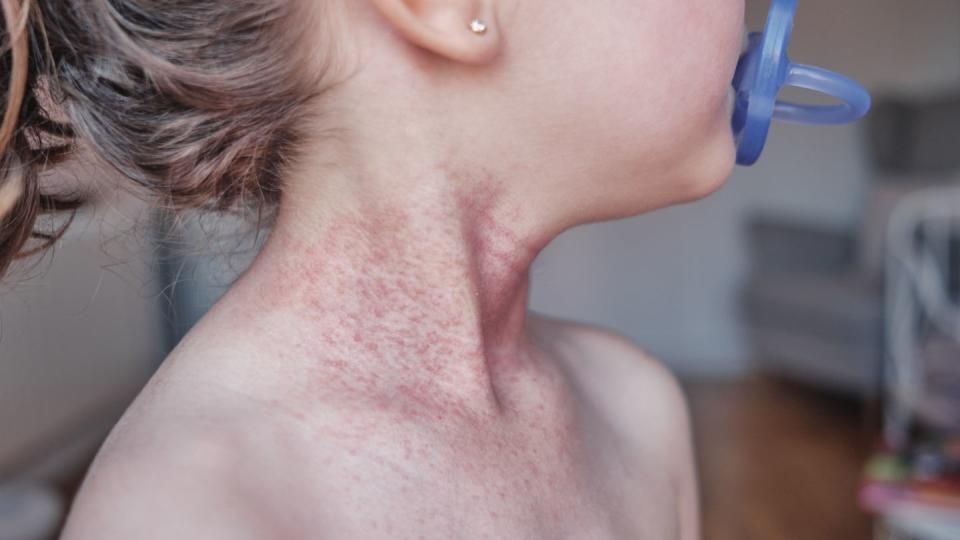
Acne
There are many different forms of acne which all have a distinct look, including small flesh-colored bumps or large, deep, painful, and inflamed nodules, says Dr. Yadav.
Some forms of acne can be treated at home by using products with ingredients like salicylic acid or benzoyl peroxide, but severe cases may need prescription topicals or oral medications, notes Dr. Yadav.
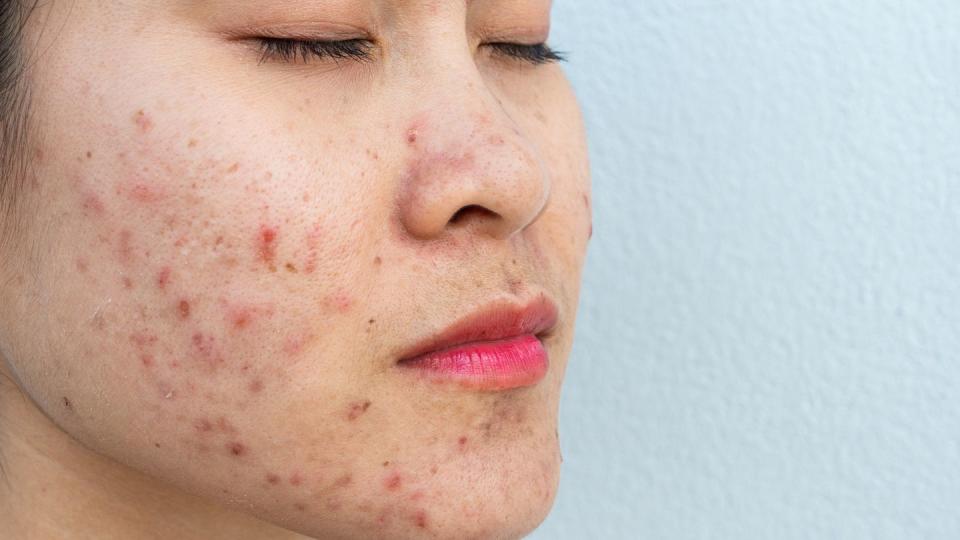
Athlete's foot
Athlete's foot is a fungal infection that looks like cracked, scaly, and peeling skin found between the toes, most commonly the fourth and fifth toes, although it can spread to other parts of your foot, says Dr. Yadav. It's very itchy and the cracks can ooze, she explains.
To treat athlete's foot, you'll have to wash and dry your feet several times a day using an antifungal cleanser and over-the-counter antifungal creams or topicals, says Dr. Yadav.
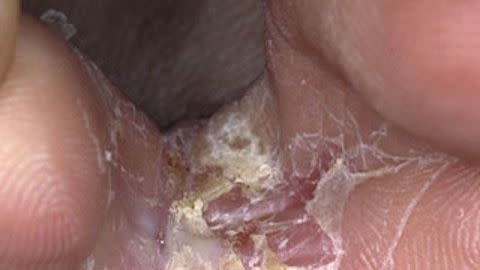
Cellulitis
Cellulitis looks like a rash, but is actually an infection of the middle layer of skin, says Dr. Yadav. It causes the skin to become diffusely red, swollen, tender, and hot to the touch, and may make skin look pitted, she explains.
Cellulitis can also cause fever with chills, fatigue, or pain in the affected area and cannot be treated at home, so you should see a doctor ASAP if you present symptoms, says Dr. Yadav.
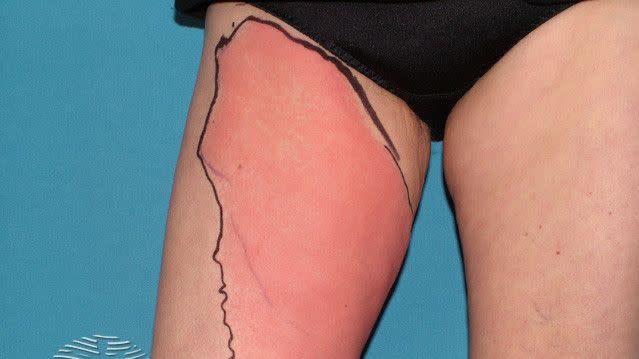
Chicken Pox
Luckily, chicken pox is rarely seen these days thanks to a vaccine, but it can still happen and presents as red, itchy, fluid-filled blisters, says Dr. Ansell. The bumps can also appear dry and/or crusty and develop blotchy scabs.
The rash is accompanied by a fever, headache, stomachache, and fatigue, and can be very dangerous to those unvaccinated, adds Dr. Ansell.
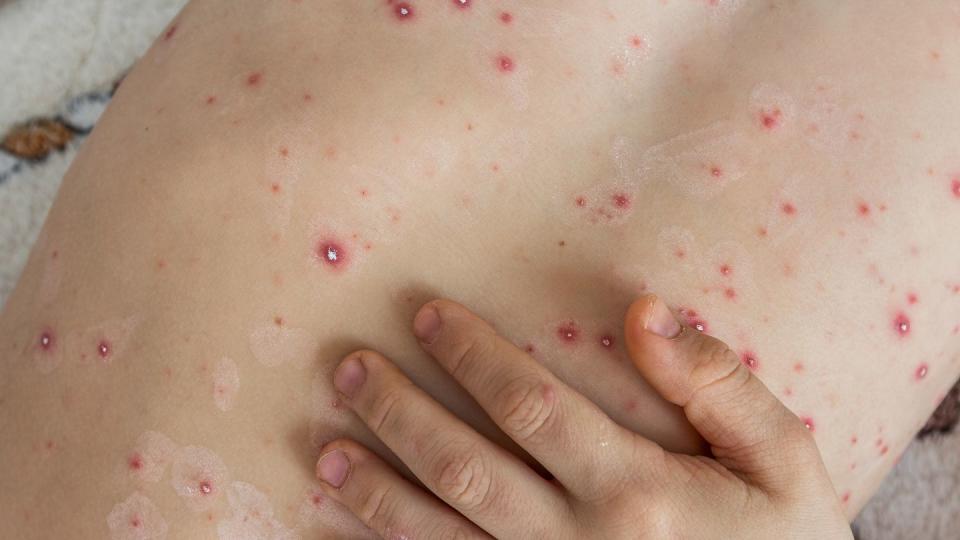
Contact Dermatitis
Contact dermatitis is when a dry, red, scaly rash that can also look like fluid-filled blisters or poison ivy appears from coming in contact with an irritant or allergen, says Dr. Parikh. The rash usually has a distinct border and may be caused by substances such as perfumes, detergents or even jewelry.
The itchy rash can develop within minutes to hours after exposure to the allergen and can cause swelling, tenderness, or a burning sensation.
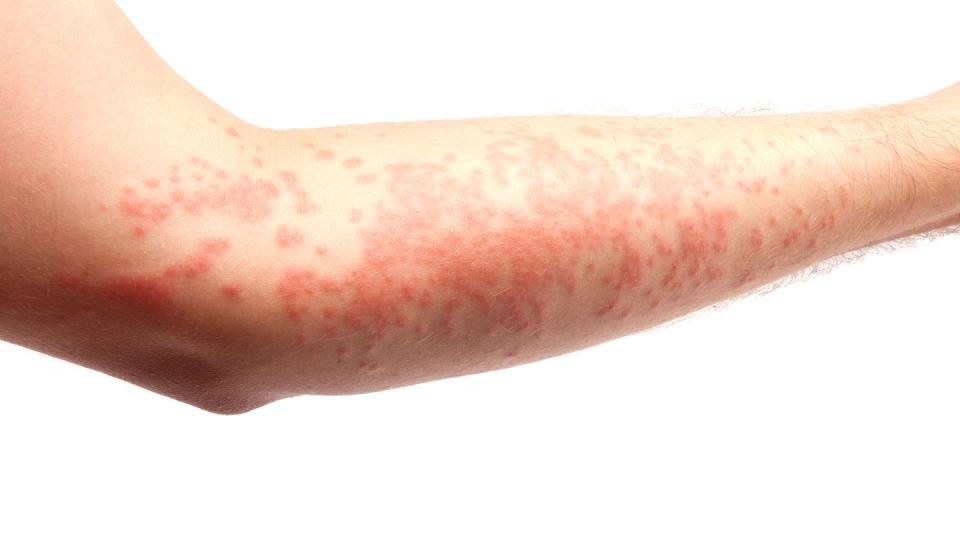
Eczema
Eczema causes dry, rough, flaky, or scaly skin that can appear red, gray, brown, or purple, depending on the skin tone, says Dr. Yadav.
“It's an inflammatory skin condition that causes a dysfunctional skin barrier, which prevents the skin from staying hydrated and nourished and makes it more susceptible to external irritants,” she explains.
The rash is itchy and clusters on the elbows and knees, but can appear anywhere on the body, and is exacerbated by cold, dry weather.
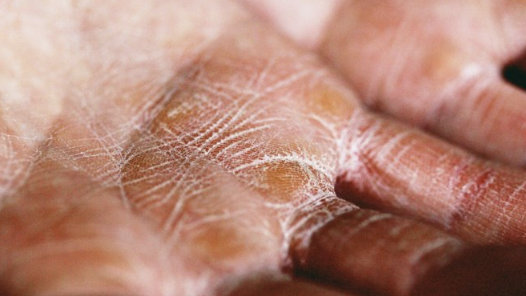
Hand, Foot, And Mouth Disease
Hand, foot, and mouth disease is caused by the Coxsackie virus and is usually seen in children under five, says Dr. Jacobs. It presents as sores in the mouth and a rash on the hands and feet but is also typically accompanied by fever and sore throat, he explains.
The condition is highly contagious, most commonly seen in daycares and schools, and spreads through coughing, sneezing, exchange of saliva, fluid from the rash, and stool, says Dr. Jacobs.
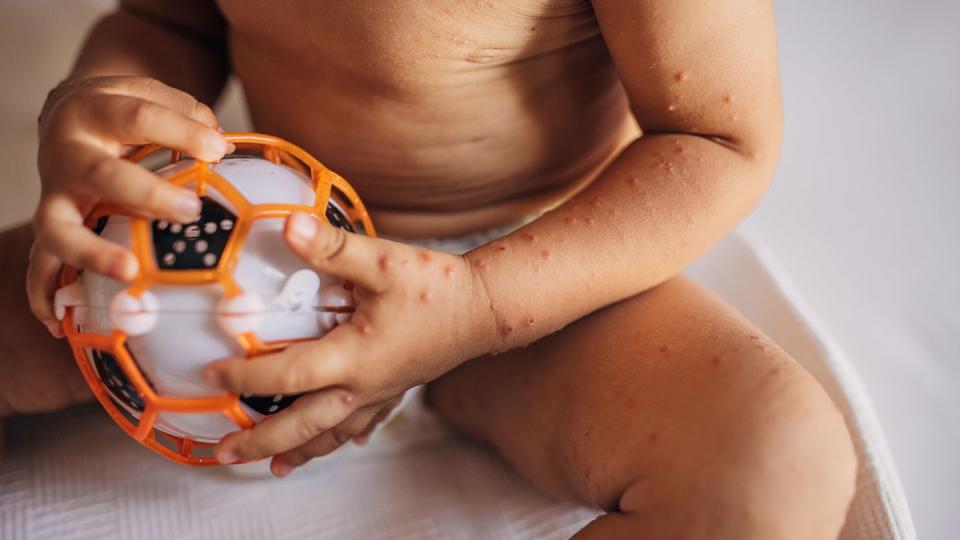
Flea Bites
Flea bites are usually seen on the lower legs around the ankles and feet, says Dr. Jacobs. The blisters are extremely itchy and often appear in a straight line or cluster of three to four small red bumps, he says.
Over-the-counter cortisone cream can help alleviate symptoms, but do not scratch or pick the lesions since that can cause further infection, Dr. Jacobs adds. If symptoms get worse or you have a fever, visit your doctor.
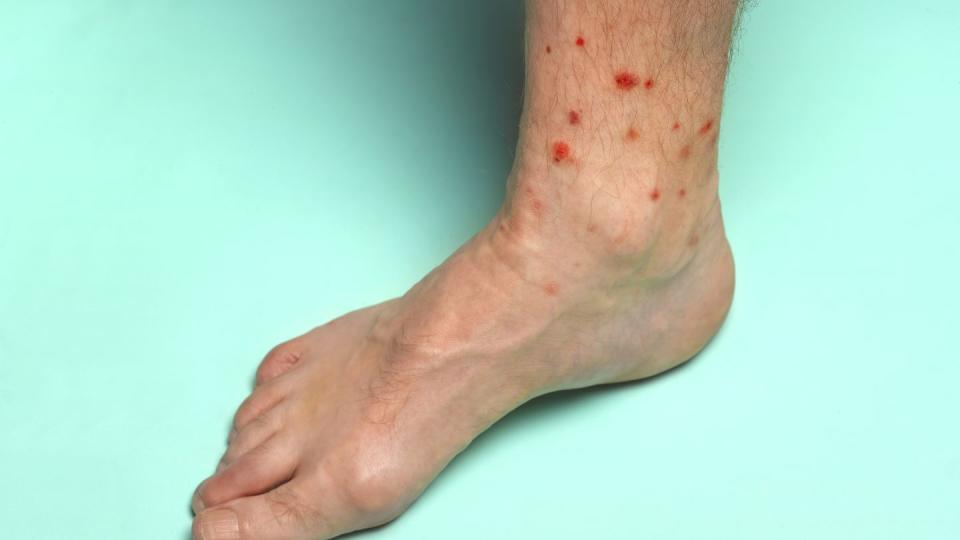
Heat Rash
Heat rash looks like small clusters of tiny pimples or blisters and can be itchy and painful, says Dr. Yadav. The rash forms when a sweat pore is blocked, trapping the sweat, and preventing it from evaporating, she explains.
It’s most common during hot, humid weather, and can make your skin feel prickly, but symptoms usually dissipate in a few days, says Dr. Yadav. If symptoms worsen, or you have trouble breathing, visit a doctor immediately.
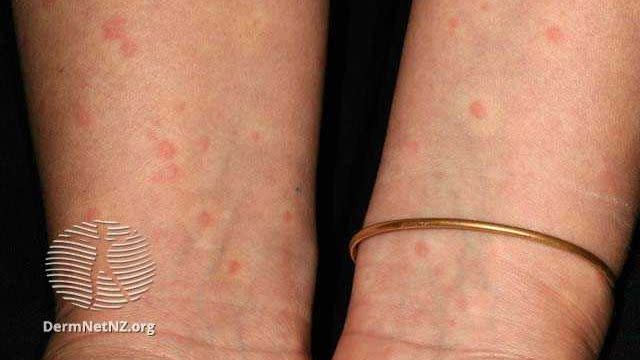
Hives
Hives are red raised welts that turn white when you press on them, says Dr. Parikh. They can range in size from small mosquito-like bites or develop into larger patches on the body, she adds.
Hives are caused by an allergen such as food, medications, or insects, and can cause swelling in lips and tongue, adds Dr. Parikh. If you experience shortness of breath, tongue swelling, or chest tightness, call 911.
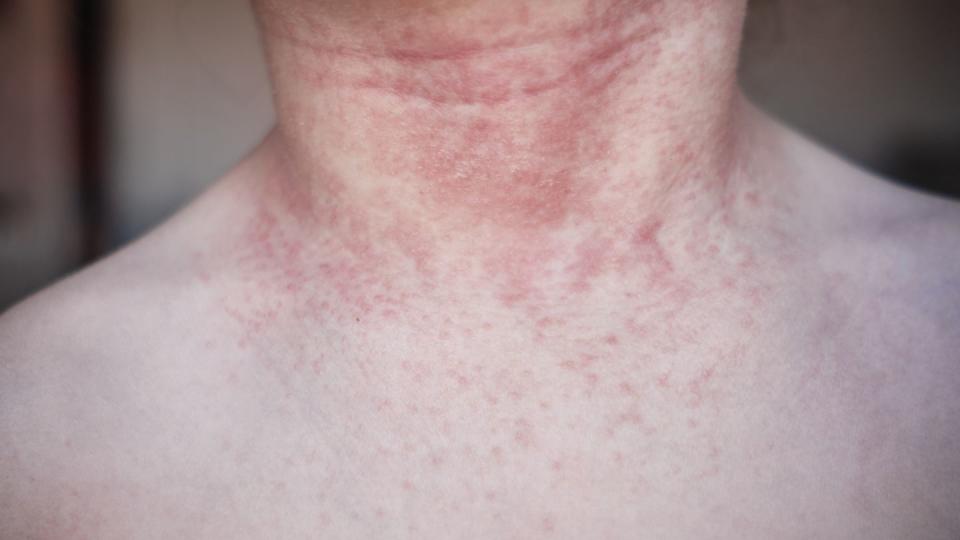
Impetigo
Impetigo is a common bacterial infection that causes red sores or blisters to form on the skin, usually around the mouth and nose, says Dr. Kamangar. The itchy sores may be pus-filled and can burst to form a yellow-brown crust over time, she explains.
The condition is caused by a bacterial infection, most commonly Staphylococcus aureus or Streptococcus pyogenes, and the bacteria enters the body through small cuts or scrapes on the skin, Dr. Kamangar explains. It’s most common in children but can affect adults and is often accompanied by fever, swollen lymph nodes, and a general feeling of illness, she adds.
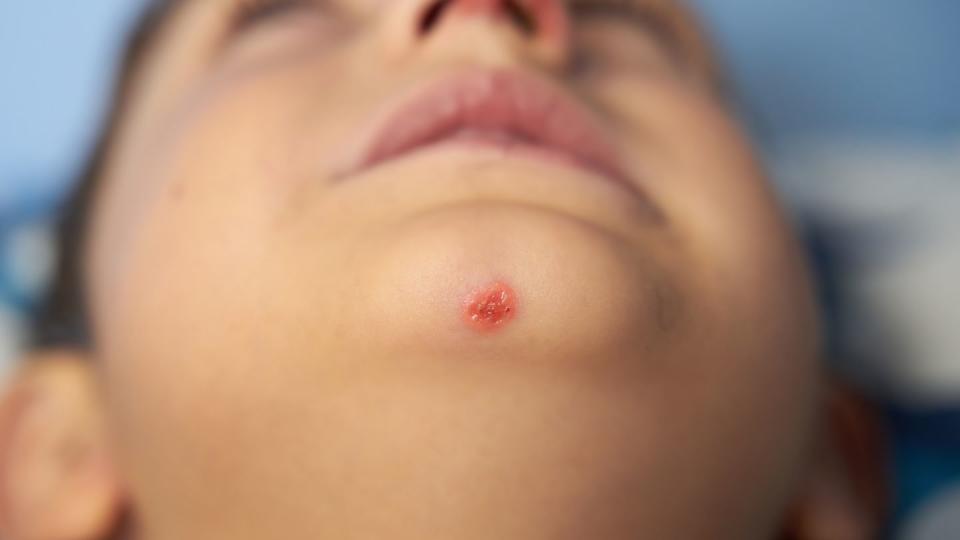
Lupus
Lupus is an autoimmune disease that causes a red scaly rash on the cheeks and nose, says Dr. Parikh. In particular, the rash is characterized as looking like a butterfly across the face, she explains. Discoid lupus can also cause round, dark, circular lesions on the face or cheeks that are scaly and resemble coins or discs, she adds.
Additional symptoms may include muscle and/or joint pain, fever, hair loss, chest pain, mouth sores, or sun sensitivity, per the Centers for Disease Control and Prevention (CDC).
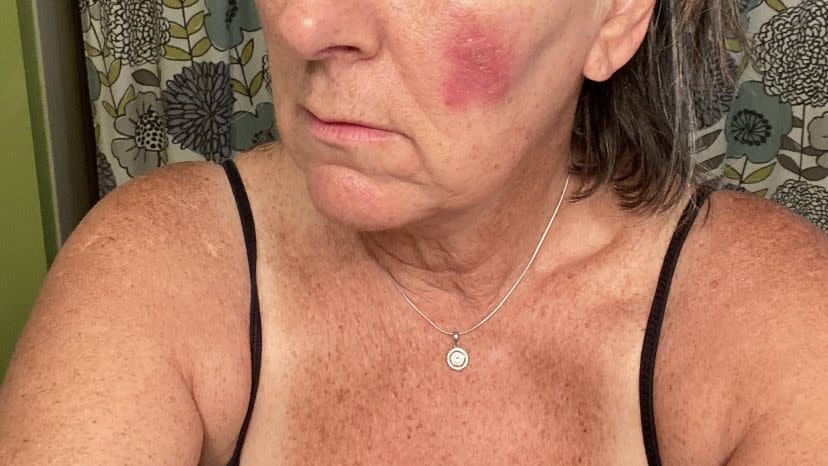
Lyme Disease
Not every tick bite leads to Lyme disease, but if the bite expands into a red patch that is not scaly, it may signal you were infected with a blacklegged tick and infected with Lyme disease, says Dr. Ansell.
At first, Lyme disease may present with a fever, headache, fatigue, and joint or muscle stiffness, and symptoms typically present three to 30 days after the bite, per the Mayo Clinic. Again, if you think you may have Lyme disease, see your doctor.
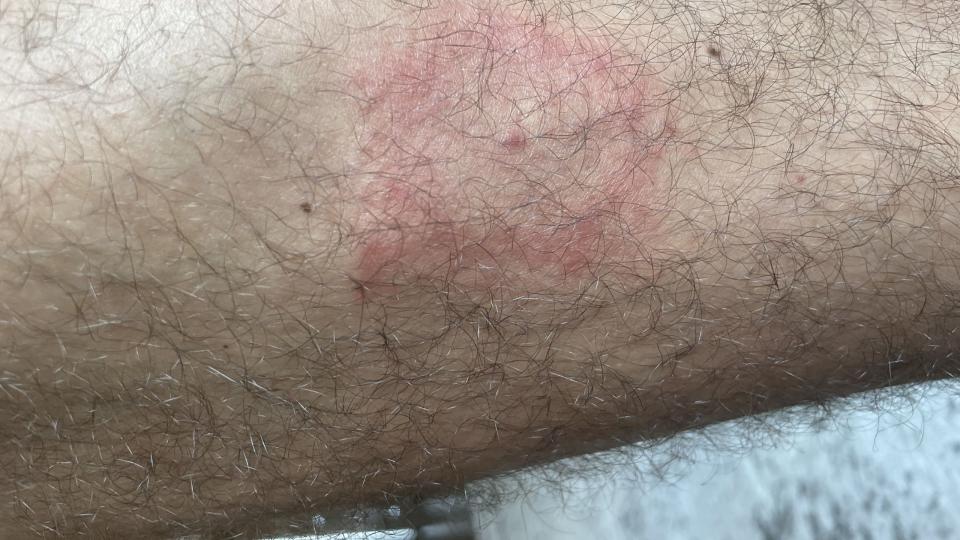
Measles
Thanks to a vaccine, measles is rarely seen these days, however it is a highly contagious airborne disease caused by a virus, says Dr. Ansell. It causes fever, cough, and red eyes that may be sore and sensitive to light, spots in the mouth, and a splotchy, red rash that appears on the face and ears, then spreads down the chest and back, she explains.
Measles can cause severe complications, especially in young people, so if you suspect you have the disease, or have been exposed to an infected person, visit your doctor immediately, per the CDC.
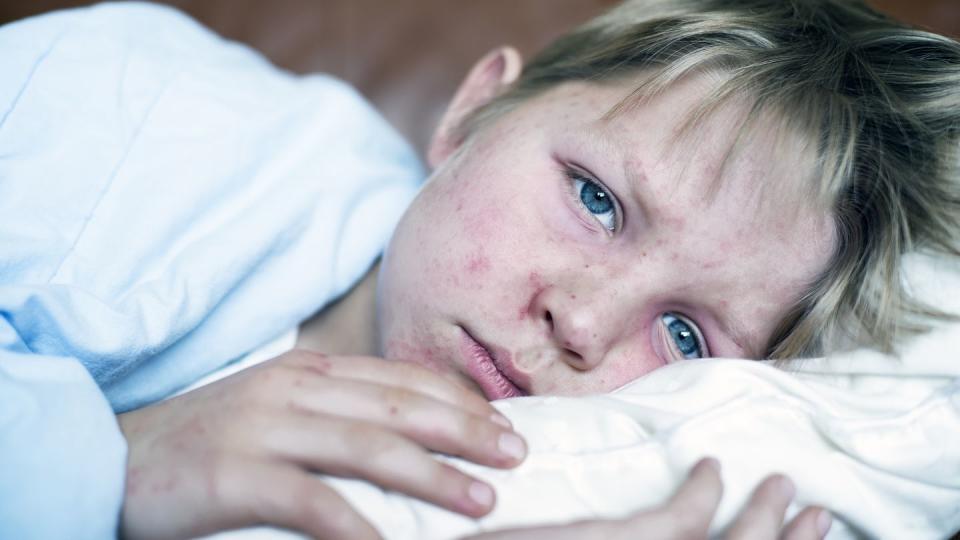
Molluscum
Molluscum is a rash caused by the poxvirus and leads to small groups of bumps on the skin, says Dr. Jacobs. “The lesions are small, elevated, pink or flesh colored, and have a central dimple,” he explains. The bumps can also become red, swollen, and inflamed, he adds.
The condition is passed through direct contact and the rash may spread to other parts of the body in those who are immunocompromised, says Dr. Jacobs.
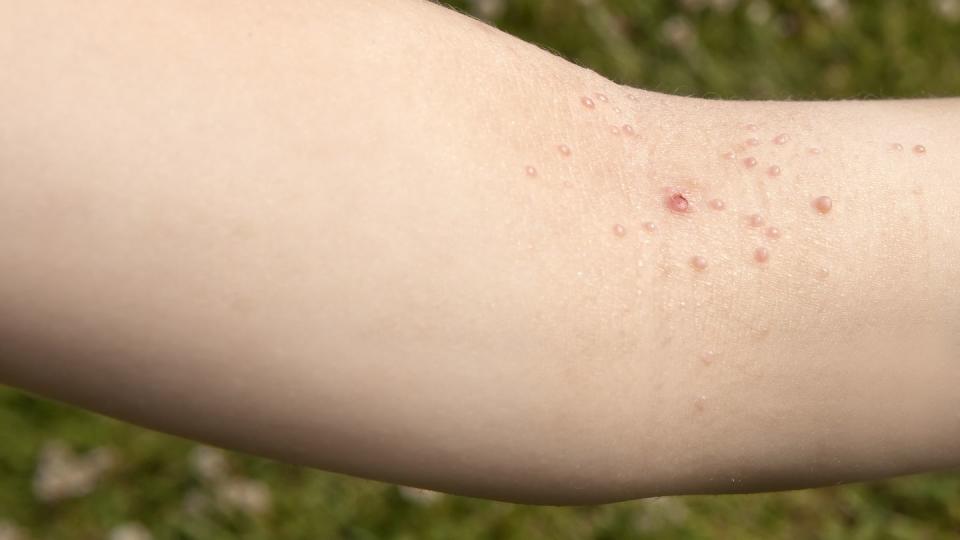
Perioral Dermatitis
Perioral dermatitis is a red rash that appears around your mouth and nose and causes red, inflamed, swollen bumps on the lower half of your face, says Dr. Parikh. The rash is very dry, itchy, and uncomfortable, and may be confused with acne, she adds.
Women ages 25 to 45 who use topical steroids and face creams are most likely to get this rash, though men can develop it, too, per Cleveland Clinic. Overuse of topical steroids is most likely the cause of perioral dermatitis, however, it may also be caused by candida albicans, a yeast, which is a type of fungus, Cleveland Clinic notes, adding that fluoridated toothpaste, gum, or hormonal contraceptives, can also cause flare-ups.
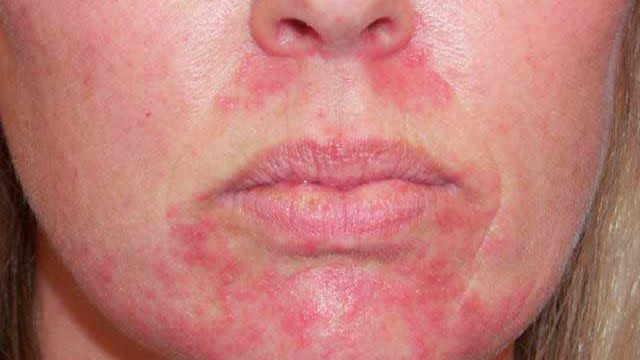
Poison Ivy
Poison ivy is caused by skin contact with the poison ivy plant and looks like a red, blistering rash that's extremely itchy, says Dr. Yadav. You may also see swelling, blisters, or black dots on the skin from the oil that has oxidized on the surface, she adds.
If exposed to poison ivy, thoroughly rinse the affected area with soap and water, and if you have difficulty breathing, seek medical attention.
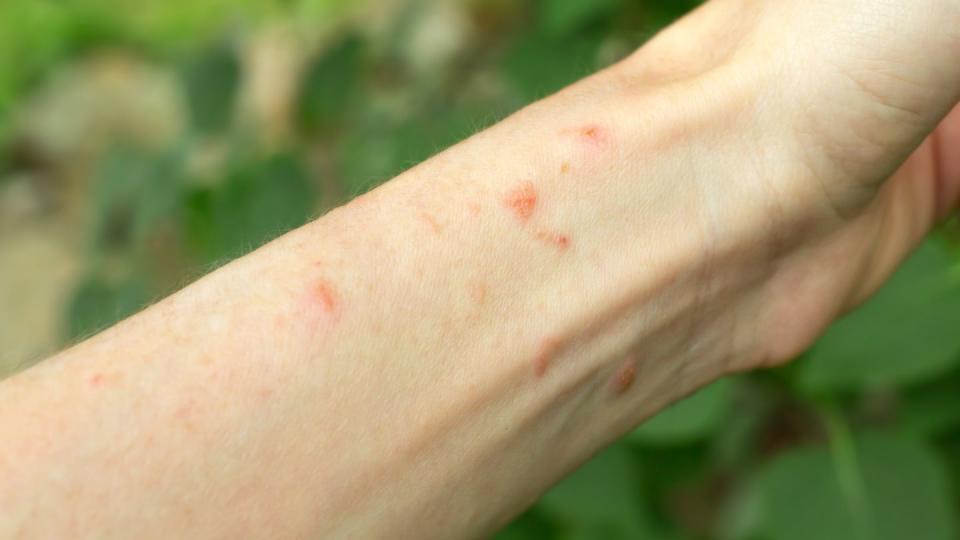
Psoriasis
Psoriasis is a chronic skin condition that causes red, scaly patches, says Dr. Kamangar. These patches can occur anywhere on the body, but are most commonly found on the scalp, elbows, knees, and lower back, and can be itchy or painful and may crack or bleed, she explains.
The exact cause is unknown, but psoriasis is believed to be related to an immune system malfunction that causes skin cells to grow too quickly, leading to the formation of the scaly patches, and may be triggered by stress, infections, or certain medications, explains Dr. Kamangar.
Other symptoms include joint pain, nail changes, and fatigue, she adds.
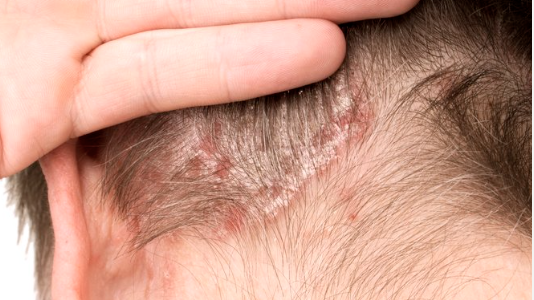
Ringworm
Ringworm is a fungal infection that causes a red, itchy, circular rash on the skin with raised edges and a clear center, says Dr. Kamangar. The rash may be scaly, bumpy, or blistered, and can occur anywhere on the body.
Ringworm is more common in warm, humid climates and in people who have weakened immune systems, but other symptoms may include an itching, burning, or stinging sensation, and loss of hair in the affected area, she adds.
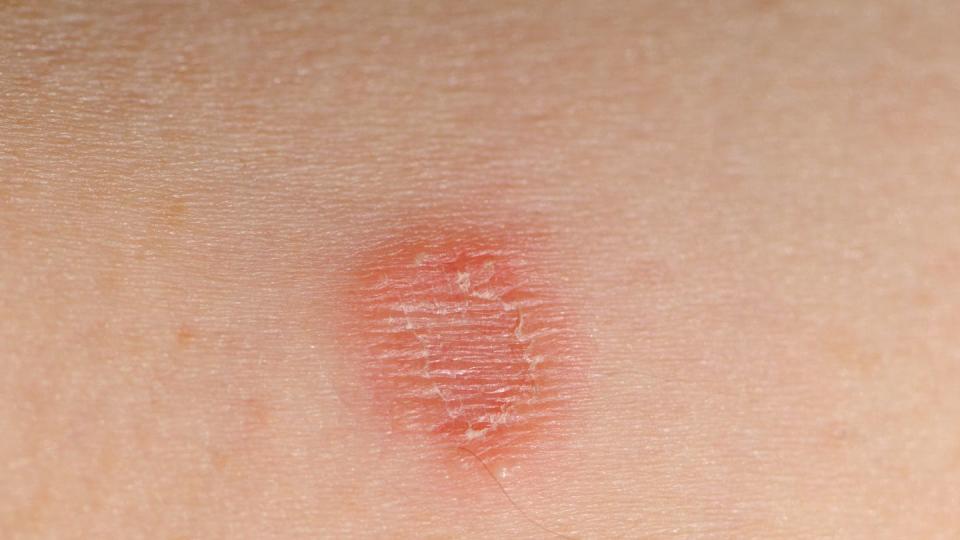
Rosacea
Rosacea is a chronic skin condition that causes redness, flushing, and small bumps on the face that may be pus-filled, swollen, tender, [and] acne-like, says Dr. Kamangar. The rash can occur anywhere on the face but is most common on the cheeks, nose, and forehead, she adds.
“The exact cause of rosacea is not known, but it’s believed to be related to an abnormal immune system response, and factors that may trigger or worsen rosacea include sunlight, stress, hot or cold weather, spicy foods, alcohol, and caffeine,” notes Dr. Kamangar.
Other symptoms may include burning or stinging sensations, dry or rough skin, and visible blood vessels on the face, she explains. In severe cases, rosacea can cause thickening of the skin and eye problems such as dryness, itching, and sensitivity to light.
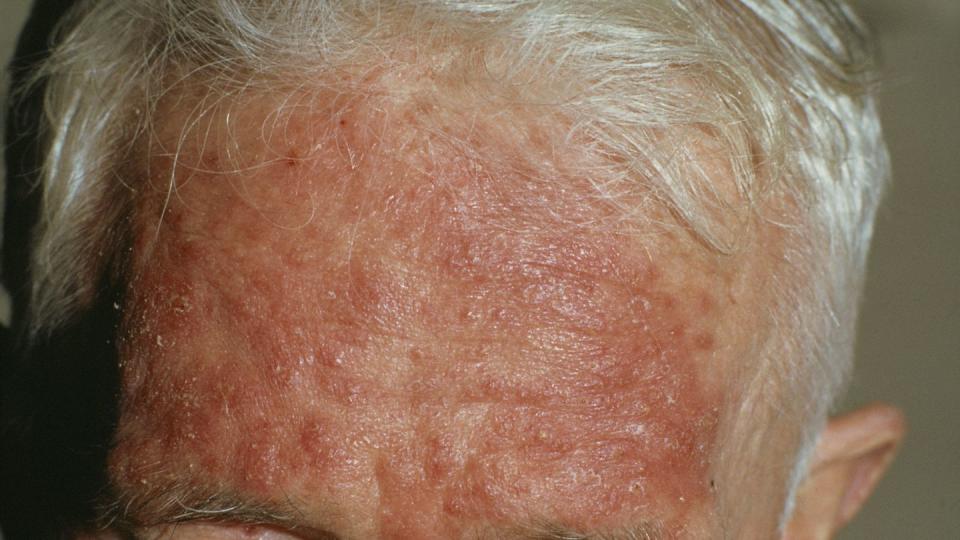
Scabies
Scabies is an itchy rash that presents with linear burrows between the fingers and belly button, says Dr. Ansell. The rash appears discolored and splotchy, and the itching gets worse at night.
Scabies is caused by an infestation of mites and is highly contagious through skin-to-skin contact, so you should see a doctor immediately if symptoms present.
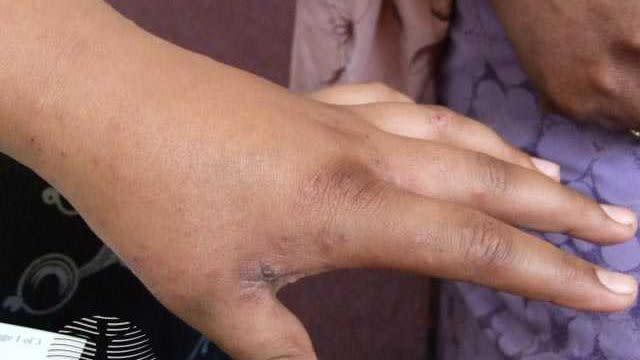
Scarlet Fever
Scarlet fever is caused by a toxin produced by group A streptococcus (the bacteria that causes a strep throat infection) and presents as a rash on the face or neck, and spreads to the chest, torso, arms, and legs, says Dr. Jacobs.
The rash is red and patchy, but can also cause a sore throat, headache, nausea, vomiting, swollen glands, fatigue, muscle aches, and redness or swelling of the tongue and throat, he explains.
If you present symptoms, see your doctor immediately since serious complications can occur, he adds.
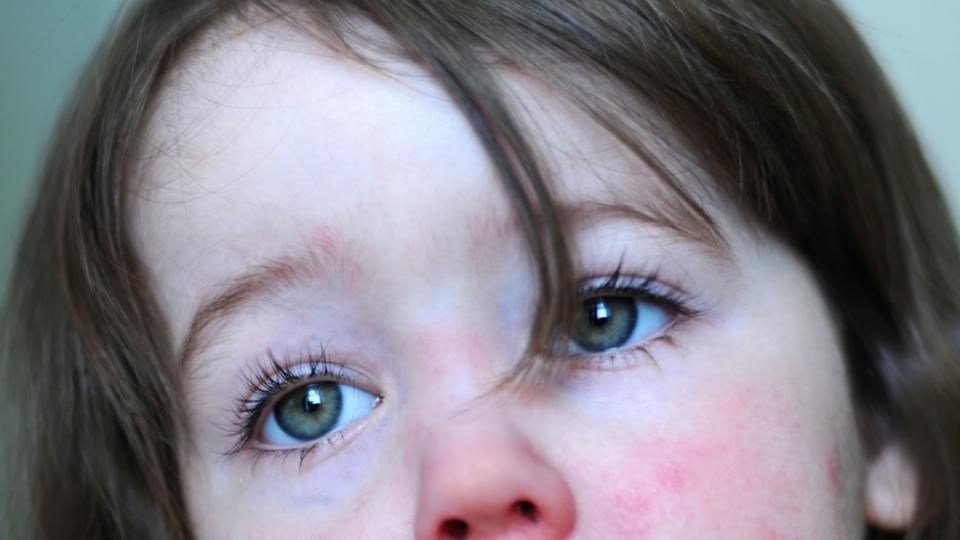
Seborrheic Dermatitis
Seborrheic dermatitis is a red, flaky rash that appears on the scalp, and is extremely itchy, says Dr. Parikh. Dandruff on your scalp, hair, eyebrows, beard, or mustache is also associated with the rash and patches of greasy skin covered in white or yellow crust can appear on the face, she adds.
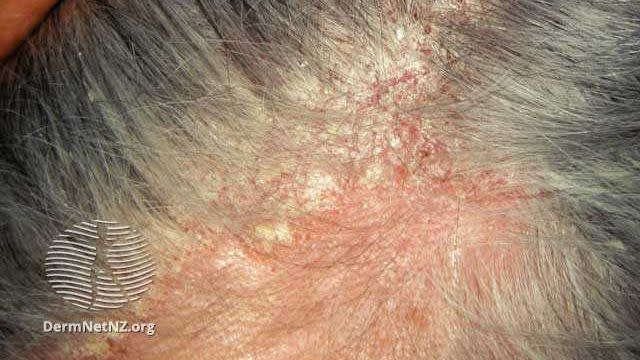
Shingles
Shingles, also known as herpes zoster, is a localized viral rash of the chickenpox virus that usually manifests on one side of the body, says Dr. Jacobs. It looks like red welts with blisters on the surface and is accompanied by a fever, headache, and chills, he says.
The condition can cause complications of the face, eyes, and/or ears, so it’s crucial to see a doctor ASAP if you suspect you have shingles, says Dr. Jacobs.
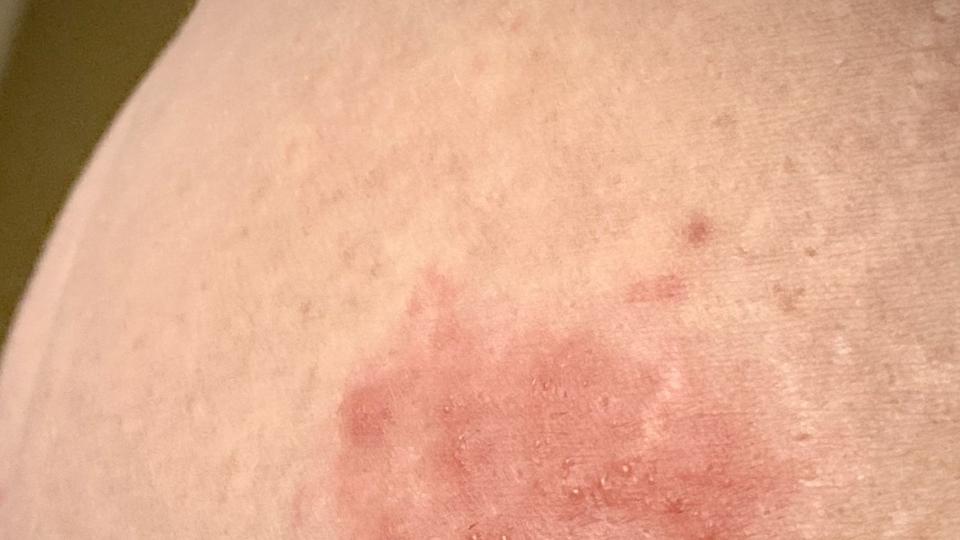
Tick Bite
A tick bite appears as a small bump, similar to any insect bite, but can develop into a red rash that looks like a bullseye, says Dr. Ansell. The bite can swell and may cause itchiness, blistering, or bruising.
Additional symptoms include fever or joint pain which is a sign you should go to the doctor since it may be an indication of Lyme disease, she adds.
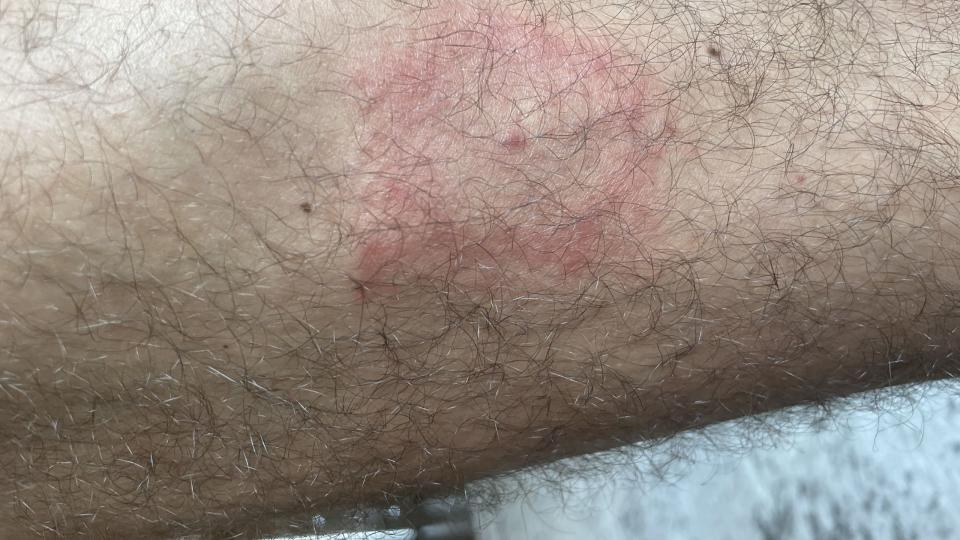
When To See A Doctor For Your Skin Rash
If you have a rash that appears quickly and spreads rapidly, you should see a doctor right away, says Dr. Yadav. “Similarly, oozing, painful, hot rashes, especially those accompanied by fever, nausea, vomiting, and other internal symptoms can be a sign of something more serious and should receive medical attention right away,” she explains.
Rashes around the genitals or eyes should also be examined by a doctor sooner rather than later, she adds. And if your rash is accompanied by fever, pain, swelling, and/or covers a large area of the body, it’s time to visit a healthcare provider, explains Dr. Kamangar.
Otherwise, if your rash is getting worse and/or doesn’t clear up on its own after a few days, it’s best to check in with your primary care physician or a dermatologist so they can properly identify the skin rash and prescribe treatment, says Dr. Kamangar. “If the rash is causing significant discomfort or interfering with daily activities, it’s a good idea to seek medical advice,” she says.

At-Home Remedies For A Skin Rash
Certain skin rashes [LIKE WHICH ONES?] can be treated at home to alleviate symptoms and Dr. Kamangar recommends moisturizing the skin with lotions or creams to reduce itching and dryness. You should also keep the area clean and dry, avoiding scrubs, sun exposure, or potentially irritating topical formulas such as fragrant body lotions or soaps, explains Dr. Yadav. Instead, try cold compresses, oatmeal baths, and aloe vera to soothe the rash, she adds.
You can also take 24-hour over-the-counter (OTC) antihistamines to reduce itching and inflammation, says Dr. Parikh. OTC hydrocortisone creams can also be applied to the rash to minimize redness and swelling, adds Dr. Kamangar. Just note that you should *not* use OTC hydrocortisone cream for more than two weeks and should stop immediately if the area becomes infected, she adds.
All that said, home remedies and OTC treatments are not a replacement for medical treatment, and if your rash worsens or becomes infected, it’s time to see a dermatologist, notes Dr. Jacobs.

You Might Also Like

